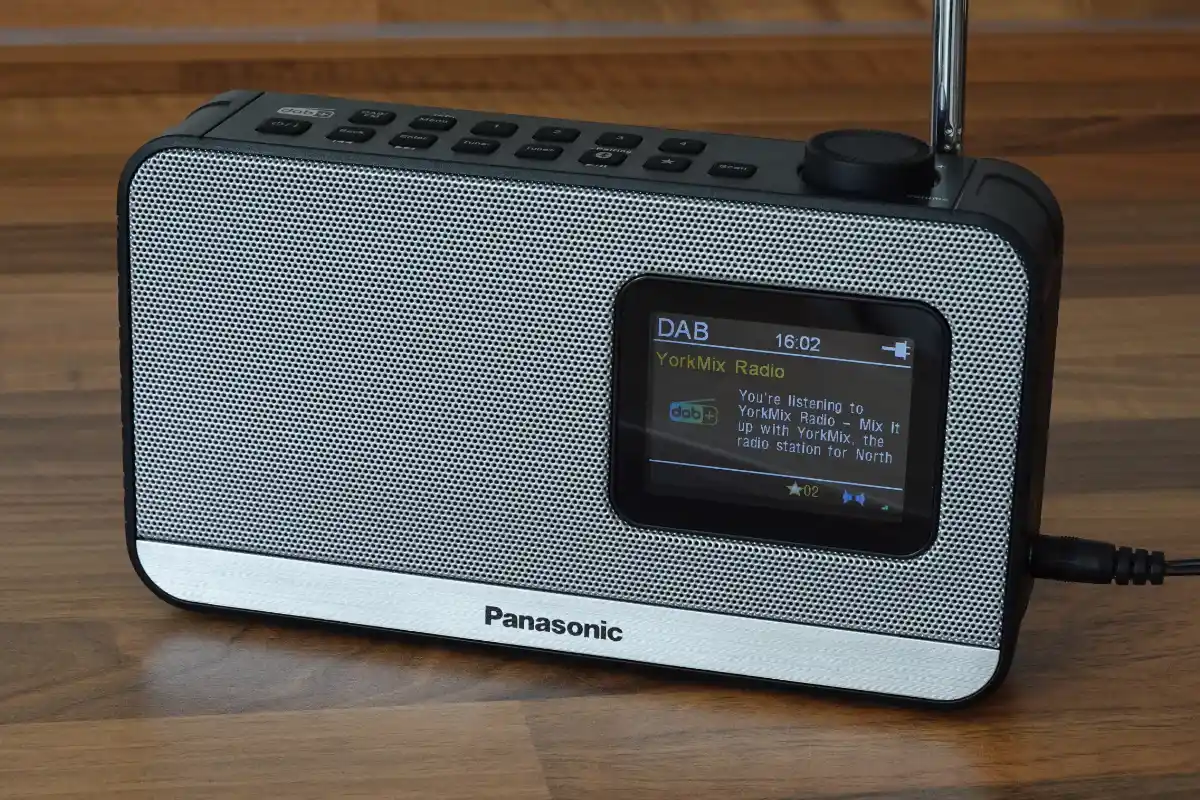The Panasonic RF-D15 is a portable DAB/DAB+/FM radio with Bluetooth. It features a single speaker and a colour display on the front, with all the controls on the top. A power supply and a printed manual are included in the box. In this review we’ll look at the RF-D15EG-K and see how it compares to other portables like the Roberts Play 20.
Features and setup
In the plain cardboard box are the radio, a power adapter and printed instruction manual.
Setting up the radio is easy and the process is typical for a portable digital radio, with the radio scanning for digital stations when switched on for the first time.
Reception is good with all the expected digital radio stations found, in addition to some not predicted to be available here for a total of 110. A scan of FM stations is completed quickly with all the normally available stations saved in a list.
Pairing a Bluetooth device is easy with the dedicated button. Pressing the button switches to Bluetooth mode, while holding the button enters the pairing mode. When pairing and un-pairing a device like a smartphone the radio makes two different sounds, which are clear but a little unexpected from a brand-name radio.
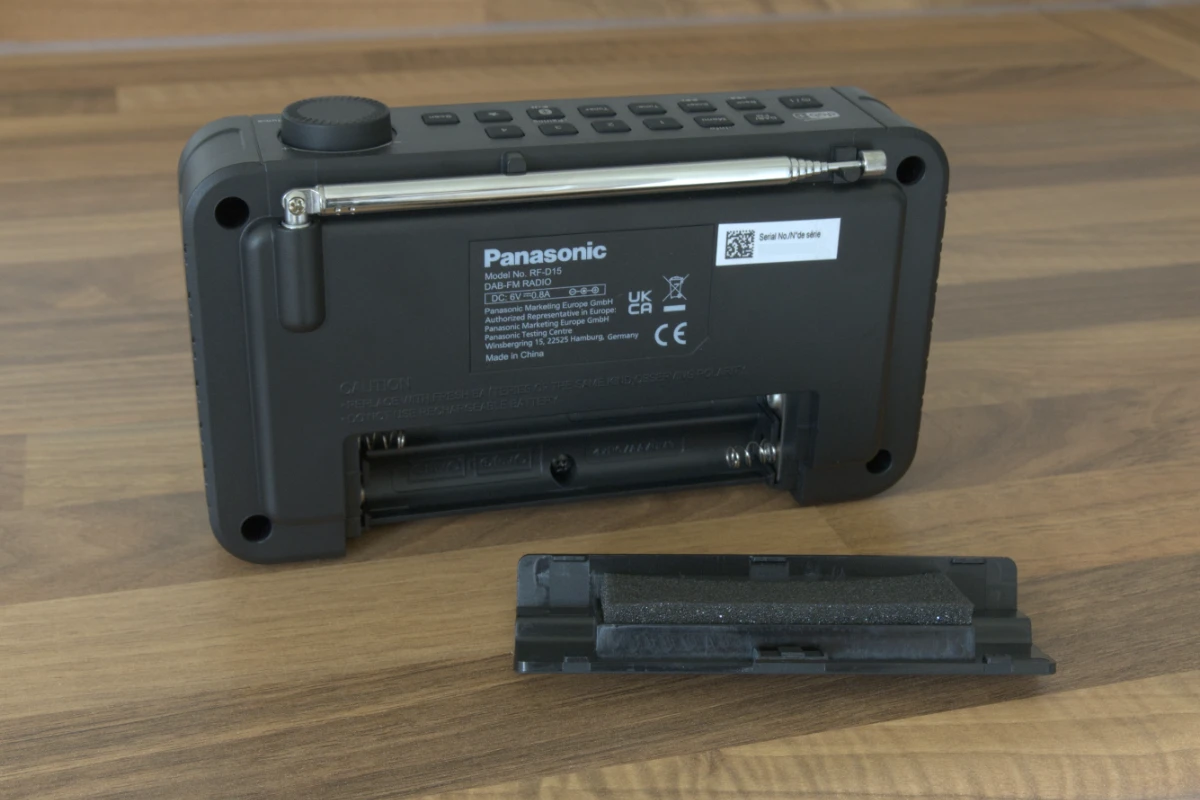
There is a PDF version available on the Panasonic website but the text is not searchable and the contents table are not clickable, which is slightly frustrating.
A one year manufacturer warranty is supplied with the radio, and Panasonic lists a support phone number and postal address alongside web chat on its website.
The RF-D15 is the latest and smallest portable DAB radio from the company. Panasonic’s larger RF-D10 has been available for several years and boasts a 10cm speaker, but lacks Bluetooth. The more modern RF-D30BT adds Bluetooth and is splash-proof while retaining EQ settings and a 2W RMS audio output power, but at a £20 premium over the RF-D10 and RF-D15.
Sound quality from the Panasonic RF-D15
There’s a 2” full range speaker behind the silver grille on the front of the radio. Audio output power is listed as 3W RMS when plugged into the mains and 1W RMS on battery power. There is no headphone output, and no EQ settings.
Initial impressions are that the radio is quite loud for a device of this size. It’s like seeing a tiny Bluetooth speaker and wondering how they get so much volume from such a small device. At under 25% volume the radio is still audible as you go between other rooms around a kitchen.
Speech radio like news, sport commentaries and phone-ins sound fine. We used the radio in a kitchen to listen to many hours of tennis, cricket and Formula 1 coverage. The overall sound of commentators over the atmosphere of the sporting action and crowds was good and at reasonable volume levels wasn’t drowned out by typical kitchen noise.
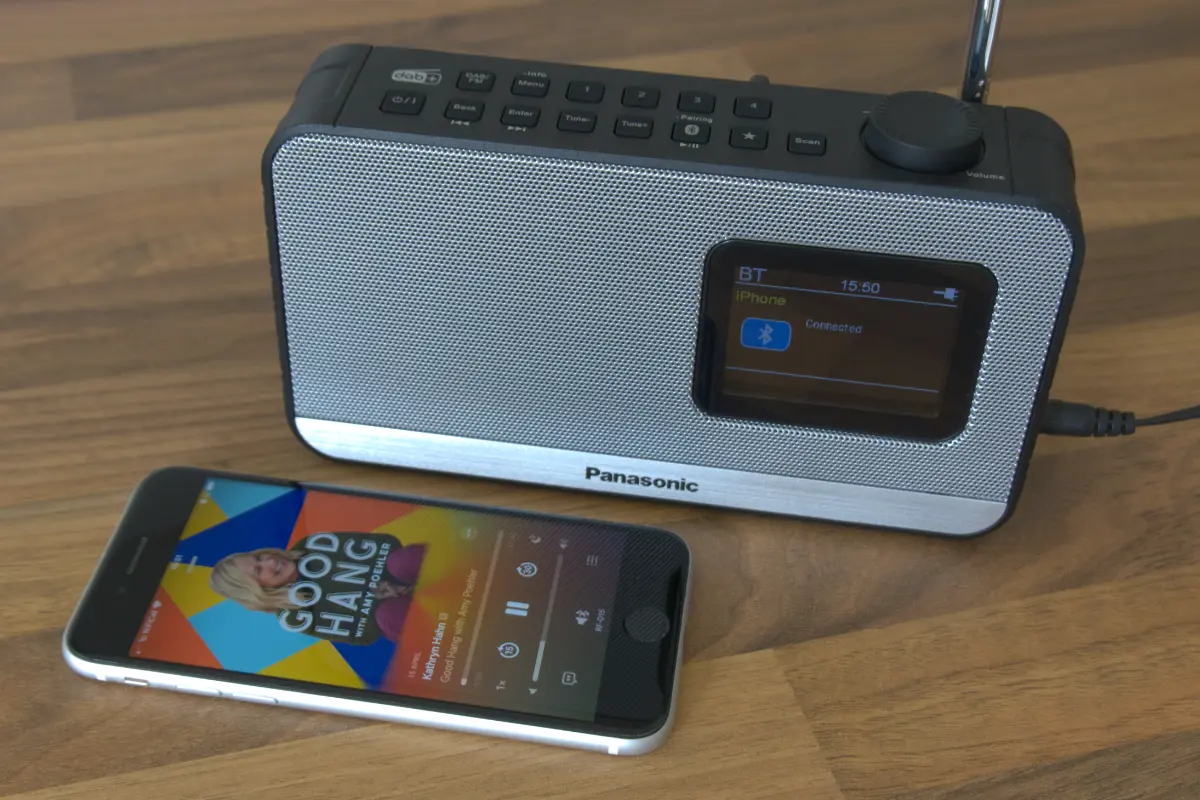
At this point we often comment on how a portable radio’s sound is fine but could be better for music listening. However, the RF-D15’s approach to music could be described as opinionated, sounding fairly different to previous portable radios we’ve tested.
When Greatest Hits Radio 80s plays a song like So Lonely by The Police there is a sense that the sound is pulsing as if parts of the song are processed differently. We found the same with Music Sounds Better With You, which prominently features the repetitive use of a sample, yet the sample sounds different as the song progresses. In other songs the radio gives the impression the sound is swirling.
Ultimately it feels as if processing or an EQ setting is being applied to the audio. It’s almost reminiscent of those sound stage settings found on AV receivers, where you can toggle through settings like ‘concert hall’ which change the character of the music. In the Bluetooth mode we found that Steely Dan songs like Josie and Kid Charlamagne sounded better, but almost as if there was radio station processing on top rather than a neutral representation of the FLAC file. Radio stations in the FM mode also sounded better than those on DAB/DAB+.
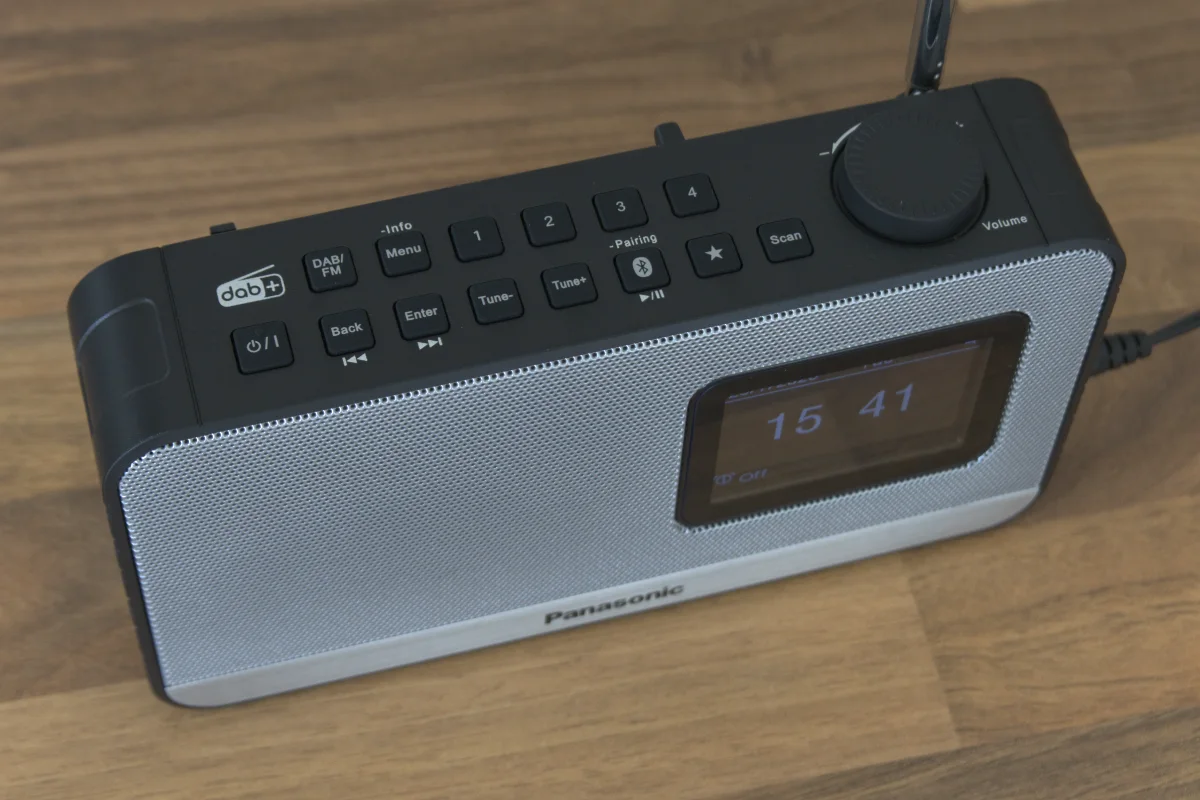
For busy environments where music is a second thought or serving as background noise the radio probably punches above similarly sized and priced devices. At a moderate volume the radio is perfectly audible over a microwave and an oven. Indeed many customer reviews highlight the sound quality: the radio certainly isn’t lacking in presence. But we found ourselves reaching for the radio on the desk as if to change the EQ settings or switch off a loudness mode, neither of which exist, or adjusting the volume in vain.
Previous digital radios from Panasonic featured a dedicated ‘EQ’ button. Had we been able to dial back the sound to something more flat and neutral we would feel much more positive about the RF-D15.
User interface
All of the controls are on the top of the radio. The small buttons across two rows have a slightly rubberised feel, with the power button being slightly bigger. Separate buttons are provided for DAB/FM and Bluetooth with a dedicated button for performing a scan of stations in either radio mode.
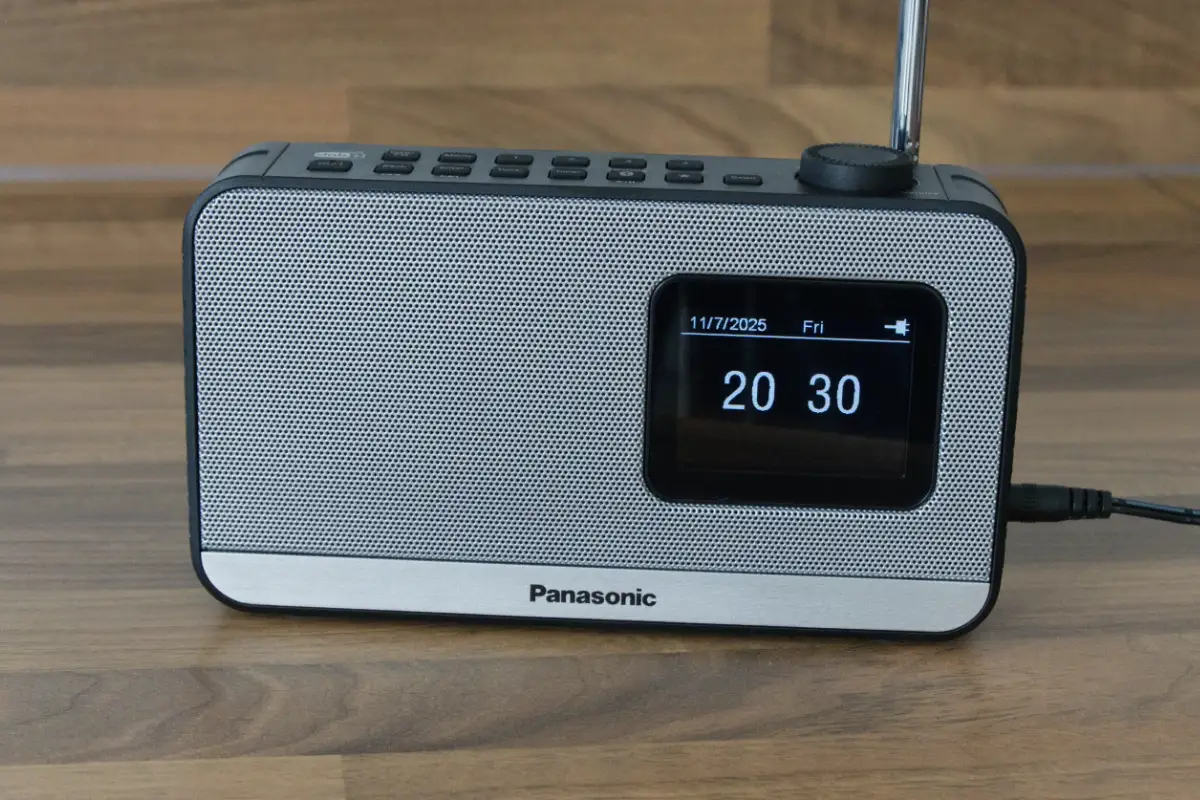
Four dedicated preset buttons (1 to 4) provide direct access to those stations, with a star denoting the preset button to open the full list of 30 available presets in each mode. Saving presets is easy: tune into a station, hold down the button until the list opens, scroll to the position to save the preset in, then press Enter. In the FM mode we found that the preset name is the frequency, rather than the station name from the RDS, leaving us to remember the frequencies of the stations we wanted to recall.
The Tune-, Tune+ and Enter buttons for changing digital radio stations took a while to get used to as we reached for the previous and next track buttons.
The front panel features a 2.4” colour display. The interface and layout is fairly typical of radios using a 2.4” display, although the font Panasonic have chosen to use isn’t the easiest to read. While it makes the radio feel more like a Panasonic product it’s not as legible and as easy to read as the font used by Pure and Roberts. In the standby mode the time is large and clear, with the date and day above.

A sleep timer is included with durations of 30, 60, 90 and 120 minutes.
Two alarms are available with options to wake up to a buzzer, FM or DAB/DAB+ radio. The alarm settings further provide for waking up to the last listened to station or a preset, with cycle options meaning different alarms can be set for weekdays and weekends.
Four AA batteries go in the compartment on the back of the radio. Panasonic say in the manual to use alkaline or manganese batteries. Text above the battery compartment cover goes further and says ‘do not use rechargeable battery’. Battery life in the Bluetooth and FM/DAB modes is given as approximately 8 hours in the specifications.
When other DAB radios do support the use of rechargeable AA batteries, or can be powered with rechargeable battery packs or internal batteries, this feels a bit of an oversight. It’s good to have the option of battery power, but this radio is probably better where mains electricity is the normal power source.
Our verdict on the Panasonic RF-D15
The Panasonic RF-D15 is a good portable DAB/DAB+/FM radio with Bluetooth. But we’re left wondering if the RF-D10 might be better at the same price if you don’t need Bluetooth connectivity. It might be easier to recommend if the sound were flatter and the interface was less unique to the Panasonic device.
If considering the Panasonic RF-D15 we’d recommend listening to a music radio station on DAB+ digital radio in a shop and comparing the sound to other Panasonic models, like the RF-D10 and RF-D30BT. Some independent electrical retailers, like our local Euronics store, carry all three – although shop conditions admittedly aren’t the best environment for this.
The Roberts Play 20 is worth considering as an alternative. It costs an extra £10, but the use of rechargeable batteries is no problem – they can even be charged in the radio – and you get an extra year of warranty. In our Roberts Play 20 review we noted that music sounded a bit soft, but that may be preferable here.
Buyers familiar with Panasonic electricals and appliances may take comfort in the typical brand design, operating instructions and support.
